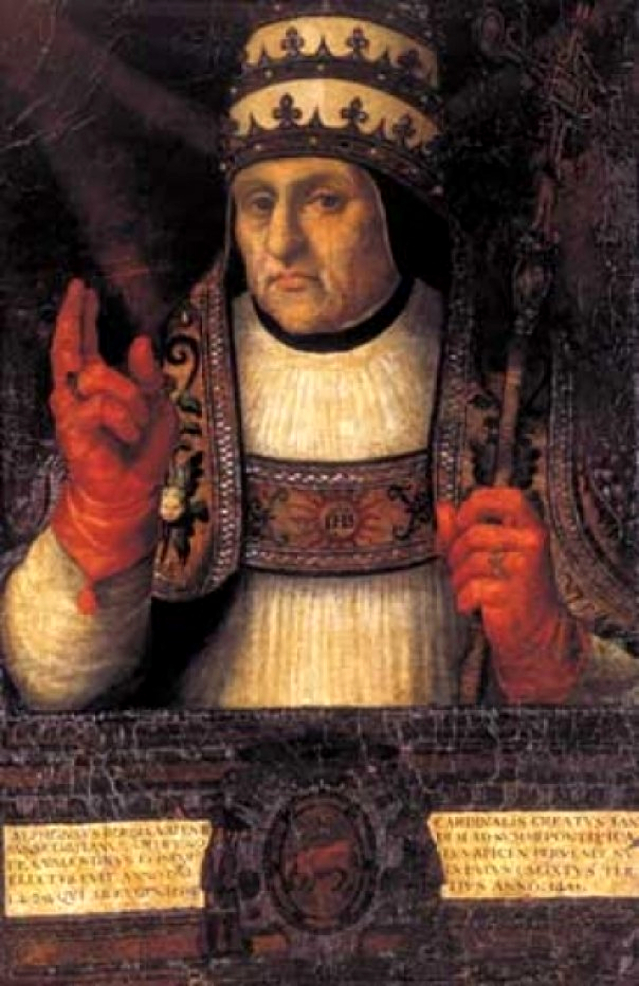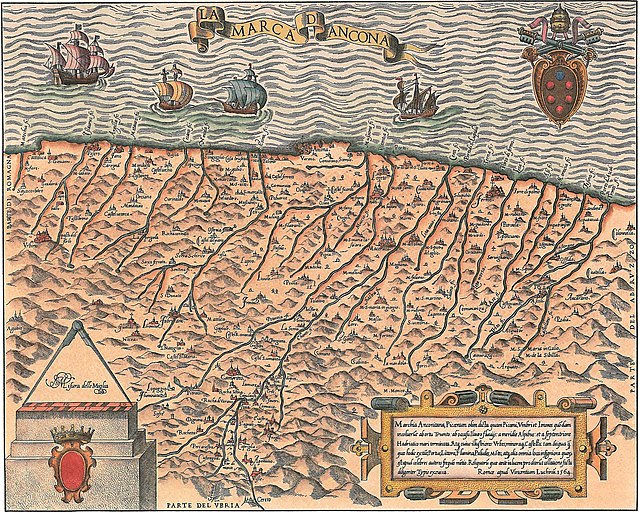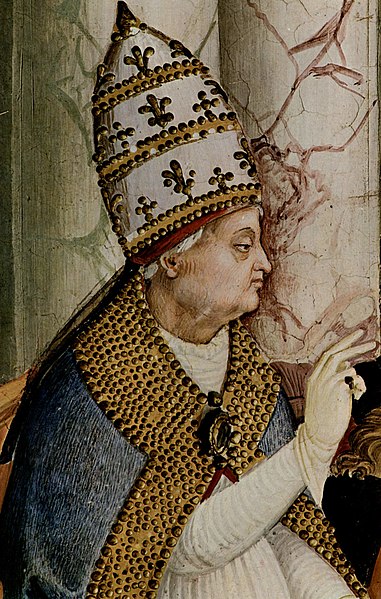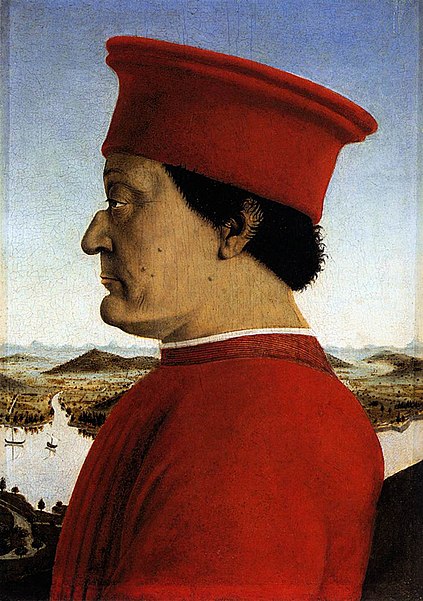 |
| Calixtus III |
The Pope’s Nephew
Rodrigo Borgia had immaculate support in his career
as a churchman; his uncle was Pope Calixtus III[i]. Calixtus became pope a bare two
years after the fall of Constantinople, a world changing event. Europe felt
the chill of Mehmet the Conqueror’s aims; Rome itself could fall to
the infidel. The event overshadowed Calixtus’ papacy and he attempted to make
the rulers of Europe aware of the Ottoman menace and sent missionaries abroad
to preach crusade.
On the eve
of his coronation Calixtus wrote to King Ladislas Posthumus of Bohemia and Hungary, one of those
on the frontline of Ottoman ambitions, telling of his dedication to crusade;
‘Even to the shedding of his
blood….that those most hideous of the Christian name should be entirely
expelled not only from the city of Constantinople…..but also from the confines
of Europe.’[ii]
Rodrigo was
the son of Joffre Llançol i Escrivà. Joffre was a noble from the town of Xativa[iii], he married his distant cousin
Isabella de Borja[iv],
daughter of Domingo de Borja. Rodrigo studied law at Bologna, where he graduated ‘the most eminent and judicious
jurisprudent’, a Doctor of Law. Upon his uncle’s elevation to the papacy
Rodrigo was made a deacon in the church and took his mother’s
surname.
Promotion
 |
| St Nicola in Carcere |
The 25 year
old Bishop of Valencia[v] was made a Cardinal-deacon[vi] of St Nicola in Carcere in Rome on 20h February
1456 ten months after Calixtus became pope. His cousin Luis de Mila was similarly honoured. Both nephews
had been given important roles within the Curia a mere twenty days of Calixtus’
accession.
‘Cardinal Rodrigo is young,
it is true, but his conduct and good sense add years to his age.’[vii]
At the same
time Rodrigo’s younger brother Pedro Luis was made Captain-General of the Church, in charge of the Papal army and
castellan of Castel Sant’Angelo.
 |
| March of Ancona |
On 31st
December 1456 Rodrigo was made Vicar General in the March of Ancona[viii], where he efficiently rid the town
of Ascola[ix] of a gang of bandits. To fund his
work in Ancona Rodrigo had to mortgage his income for the next three years. This
was in despite of the gift from Calixtus; the Bishopric of Girona, an attempt to improve Rodrigo’s
finances.
Rodrigo’s
next posting was Rome where Calixtus was attempting, through the agency of
Pedro Luis, to overthrow the rule of the Orsini family to the north and west of Rome. In 1457 Rodrigo was promoted to
the post of Vice Chancellor of the church. In the summer of 1458
Calixtus was planning further promotions for his nephews when he fell ill.
Disaster
 |
| Castel Sant'Angelo |
The Romans,
especially supporters of the Orsini family, were more than pleased when the 79
year old Borgia pope sickened in early August 1458 and it became exceptionally
dangerous to be a Spaniard in Rome. The Spanish were attacked on the streets
and a number of houses and warehouses belonging to Spanish merchants were set
ablaze.
On 5th
August Pedro Luis surrendered the keys to the Castel Sant’Angelo and he and
Rodrigo mustered 3,000 mounted troops and 200 infantry. The Romans’ hatred
focussed on Pedro Luis who was a marked man. He managed, with his brother’s
help, to escape to the papal fortress of Civitavecchia of which Pedro Luis was Captain-General. Rodrigo returned to
the Vatican to be with his uncle when he died on 6th August 1458.
 |
| Cardinal d'Estouteville |
In the
ensuing enclave it was Rodrigo who cast a block buster vote for Cardinal
Piccolomini, helping break a threatened deadlock in the cardinals’ voting. Piccolomini’s
main rival was a Frenchman, the Cardinal of Rouen, Guillaume d’Estouteville. Piccolomini had warned Rodrigo
against voting for his opponent;
‘If you have no thought for
the Church of Rome…..for whom you are preparing yourself such a vicar, at least
take thought for yourself, for you will find yourself among the hindmost, if a
Frenchman is pope.’[x]
The new pope
Pius II made Rodrigo one of his protégé’s
and his continuing rise was assured. Pius confirmed Rodrigo as Vice Chancellor.
What Rodrigo was unable to do was to save his younger brother. News reached
Rodrigo on 26th September that Pedro Luis had died en-route to
Civitavecchia of malaria.
The Pius Papacy
 |
| Pius II |
Pius
followed Calixtus’ example by preaching a crusade against the infidel newly
enthroned in Constantinople. He invited Europe’s rulers to send representatives
to Mantua in the summer of 1459. Very few representatives arrived at
the conference; the Venetians were not prepared to support a crusade.
The French
were unhappy because Pius had failed to support the French candidate for the
throne of Naples, instead he promoted the cause of Ferrante. Before leaving Mantua Pius declared
that, despite the lack of support, there would be a crusade and that it would leave
from Ancona in 1464.
Upon his return
to Rome Pius was forced to support Ferrante against his enemies. Not only the
pope, but Milan and Skanderbeg of Albania sent assistance to Naples.
With this help Ferrante’s position stabilised and he was able to increasingly
interfere in Italian politics.
 |
| Sigismondo Malatesta |
War torn Romagna was being brought under the sway of Sigismondo Malatesta, Lord of Rimini. Control of the Papal States was slowly being drained away by local lords determined on
independence from the church. But Pius’ ambitions were focussed abroad on his
crusade; he emptied the Vatican treasury to build galleys and hire crews. He
told his cardinals;
‘The call ‘Go!’ has been
unheeded; perhaps the call ‘Come!’ will evoke a heartier response….We do not
intend to fight. We shall imitate Moses who prayed on the mountain while Israel
fought Amalek. On the ship’s prow or on the mountain top we shall entreat our
Lord Jesus Christ victory for our soldiers in battle.’[xi]
Pius died on
14th August 1464 in Ancona; whence he’d travelled to launch his
crusade, but the crusade died with him.
The Popes’ Servant
 |
| Pope Paul II |
The new pope
was the Venetian Pietro Barbo who became Pope Paul II on 30th August. Paul was an eccentric who slept during the day and
gave audiences only at night. Like his predecessors Paul showed great
confidence in Rodrigo’s abilities, expanding his responsibilities and
authority. The number of Curial offices that Rodrigo was responsible for was
increased and several Spanish benefices were showered on him. In 1468 Rodrigo
was ordained to the priesthood and three years later was consecrated bishop and
was made Cardinal-Bishop of Albano.
Paul was
determined to increase the Papal holdings in Italy and chose Federico da Montefeltro, Duke of Urbino, as his military champion. Montefeltro brought Rimini back into the fold
and Malatesta under control. Further gains by Montefeltro were quickly taken by
the Orsini. Paul’s greedy eyes then fell on Bologna but his luck was out.
 |
| Federico Montefeltro |
Like his
predecessors Paul was determined on a crusade against the Turk and wrote to his
fellow monarchs;
‘Beloved Sons, there must be
no delay, because our enemy, who seems to desire nothing more than the bloody
extermination of all Christendom, [is] already at our throats, grows stronger
every day……..is strengthened in his resolve.’[xii]
Paul was
able to energise the states of Italy into forming a defensive alliance against
the Turk on 22nd December 1470. Paul died suddenly on 26th
July 1471 and his replacement Francesco della Rovere took the name Sixtus IV.
Travels in Spain
Expanding on
Paul’s initiative Sixtus called for a crusade against the infidel and sent
Rodrigo out as one of his envoys. Rodrigo was sent to Spain as Papal Legate and envoy for a crusade against the Turk.
 |
| King Henry IV |
While Rodrigo
was in Spain he persuaded the Catalans to enter peace talks with king Juan of Aragon. Barcelona accepted Aragon rule and Juan accepted Rodrigo’s
proposal that the city’s defenders be given a general pardon and that Juan
should uphold the Catalan constitution. As a way of consolidating the peace
Rodrigo awarded the dispensation that validated the marriage between Ferdinand of Aragon and Isabella of Castile[xiii] that had taken place three years earlier.
Rodrigo then
travelled to the court of Castile where King Henry IV[xiv] was warring with those claiming
Isabella as heir to the throne and those supporting Henry’s daughter Juana.. Rodrigo persuaded Henry to
repudiate his daughter who was claimed to be the child of Beltran de la Cueva, the Duke of Albuquerque. In return
Henry’s favourite bishop was to e promoted to the College of Cardinals.
Rodrigo met
with the Bishops of Léon and Burgos in Segovia; launching a reform of the church in Spain, setting up some of Europe’s
first diocesan seminaries, thus ensuring in future that priests would be
ordained with a knowledge of Latin and theology.
 |
| Segovia |
By the
summer of 1473 Rodrigo had been in Spain over a year and his enemies had not
been slow to take advantage of his absence. Cardinal Jacopo Ammanati-Piccolomini[xv] wrote to Rodrigo suggesting that an
early return was needed to counter the influence of the pope’s nephews. At the
same time Ammanati was writing to other correspondents blackening Rodrigo’s
name complaining of his behaviour as;
‘Vain, luxurious, ambitious,
[and] greedy’[xvi] and he claimed that while in Portugal
Rodrigo spent ‘most of his time with the ladies.’[xvii]
Bibliography
Italian
Dynasties – Edward Burman, Equation 1989
Lucrezia
Borgia – Rachel Erlanger, Michael Joseph 1979
The Grand
Turk – John Freely, IB Tauris & Co Ltd 2012
Florence and
the Medici – JR Hale, Phoenix Press 2001
The Rise and
Fall of the House of Medici – Christopher Hibbert, Folio Society 2001
The Borgias
– Mary Hollingsworth, Quercus Editions 2014
The Borgias
– GJ Meyer, Bantam 2013
A History of
Venice – John Julius Norwich, Penguin Books 1982
Absolute
Monarchs – John Julius Norwich, Random House 2011
A
Renaissance Tapestry – Kate Simon, Harrap 1988
The March of
Folly – Barbara Tuchman, Cardinal 1990
www.wikipedia.en
[i]
A compromise candidate, selected due to his extreme age (77), it was believed
that he would soon die and the throne up for grabs again
[ii]
The Grand Turk - Freely
[iv]
The Spanish spelling of the name
[v]
Rodrigo inherited the bishopric upon
his uncle’s accession to the throne of St Peter
[vii]
The Borgias - Meyer
[ix]
Now Ascoli Piceno
[x]
The Borgias - Meyer
[xi]
A History of Venice - Norfolk
[xii]
The Grand Turk - Freely
[xiii]
Both cousins many times over
[xiv]
Known as the Impotent
[xv]
Adopted into the late Pius II’s family
[xvi]
The Borgias – Meyer
[xvii]
Ibid
No comments:
Post a Comment
Note: only a member of this blog may post a comment.